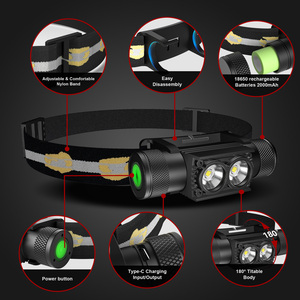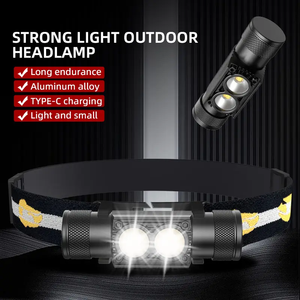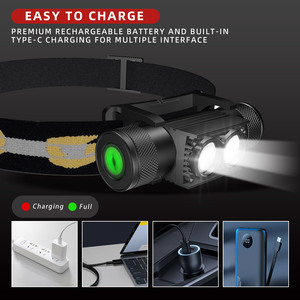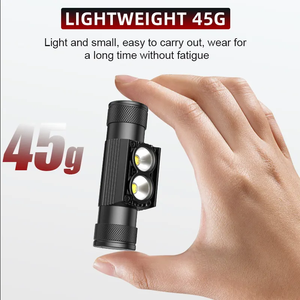
All categories
Featured selections
Trade Assurance
Buyer Central
Help Center
Get the app
Become a supplier

(56 products available)

































Husky headlamps are essential lighting devices that offer hands-free illumination for various activities. These headlamps provide different lighting solutions for outdoor enthusiasts, professional trades and emergency preparedness. Here are the key types of husky headlamps:
Husky LED Headlamps
Husky LED headlamps are popular for their durability and energy efficiency. They use light emitting diodes as their source of light. These LEDs have long lasting batteries, thus providing a powerful beam of light. Husky LED headlamps are commonly used for camping, hiking and other outdoor activities. They are also applicable in professional uses such as construction, emergency services and maintenance.
Husky Rechargeable Headlamps
Husky rechargeable headlamps are convenient and cost effective, eliminating the need for frequent battery replacements. They come with a built in USB charging port. This feature allows easy charging using a solar charger, power bank or wall charger. They are environment friendly and provide a consistent bright light. They can be used for running, backpacking or other outdoor activities.
Husky Solar Powered Headlamps
Husky solar powered headlamps are fitted with solar panels that charge the internal battery using sunlight. They are useful in areas with minimal or no access to electricity. These headlamps are popular for their eco-friendliness and sustainability. They are mainly used for outdoor adventures and activities in sunny regions.
Husky Sensor-Activated Headlamps
These headlamps offer convenience and ease of use. They are equipped with motion sensors that activate the light when the head is tilted at a certain angle. This feature enables hands-free operation. Sensor activated headlamps are useful in situations where quick illumination is required. They are applicable in climbing, trail running and emergency situations.
Husky Smart Headlamps
Husky smart headlamps come with advanced features designed for versatility and convenience. They offer multiple lighting modes such as red light, high beam and strobe. These smart headlamps have an adjustable brightness level and a battery indicator. Additionally, they may have Bluetooth connectivity for smartphone integration. They are ideal for a wide range of activities such as mountaineering, cycling and fishing.
Headlamps are becoming more popular because of their versatility. From outdoor activities to home improvement, construction, and emergency services, headlamps are used in a wide range of applications. They are more preferred than traditional flashlights because they allow users to have hands-free lighting while directing the light where needed.
Husky headlamps come with different features and functions that enhance their performance and make them more convenient for users. Here are some of them:
Brightness Levels
Many Husky headlamps have different brightness levels. This allows users to adjust the amount of light depending on the task or environment. Users can switch to low lumens when working up close to conserve battery power and avoid blinding or hurting their eyes. Some models have up to five brightness levels.
Light Modes
Different Husky headlamp models come with different light modes. These include; flood mode, which provides a wide beam for up-close tasks, and spot mode, which produces a concentrated beam of light for long-distance viewing. Some headlamps also have red light mode, which is useful for preserving night vision and reading maps.
Battery Life
The battery life of a headlamp determines how long it can be used before recharging or replacing the batteries. It varies from one model to another and depends on the brightness level and light mode being used. Some headlamps can last for several hours or days in low settings without interruption.
Water Resistance
Most Husky headlamps are water resistant. They can be used in wet or rainy conditions without being damaged. Water-resistant headlamps have an IPX rating of 4, while those that are waterproof have an IPX rating of 6 and above. Such headlamps can be immersed in water for a short period of time.
Adjustable Straps
These are elastic bands that secure the headlamp on the user's head. They are comfortable, lightweight, and offer hands-free lighting. Some models come with a top strap for added stability, especially when the headlamp is used for outdoor activities like hiking and running.
Dimming Feature
This allows the user to adjust the brightness level smoothly. It is useful for preserving battery life when less light is needed. It can also be used to avoid blinding other people in proximity.
Lock Function
Some Husky headlamps have a lock function. This prevents accidental switching on when the headlamp is packed in a gear bag or backpack. It helps to conserve battery life when the headlamp is not in use.
Husky headlamps have a variety of application scenarios, making them essential equipment for outdoor lovers, professionals, and emergency responders. Here are some common usage scenarios:
Outdoor Activities
Husky headlamps are commonly used by outdoor lovers engaged in activities like; hiking, camping, climbing, and trail running. They offer hands-free lighting during evening hikes, setting up camp and cooking meals, as well as navigating trails.
Work and Professional Use
These headlamps are regularly used by different professionals in various industries. For example, construction workers, electricians, and mechanics use them while working in tight spaces or dimly lit areas to enhance visibility and improve task efficiency.
Emergency Preparedness
Husky headlamps are commonly used by emergency responders such as; firefighters, search and rescue teams, and paramedics. These headlamps provide reliable illumination during emergencies and rescue operations in low-light conditions and are essential components of emergency kits for typical households.
Home Improvement and DIY
These headlamps are useful for tasks around the house, such as; repairs, inspections, and renovations. They offer focused lighting while working in basements, attics, or cramped spaces.
Caving and Spelunking
Husky headlamps are essential for individuals exploring caves and caverns. They offer constant lighting required to navigate through dark and uneven terrains without relying on handheld lights that may fall or impede movement.
Nighttime Photography
These headlamps can be used by photographers to position equipment, set up shots, and perform tasks without disturbing the light while taking pictures in dark places.
Reading and Relaxing
Husky headlamps with dimmer settings and without a red light can be used for reading purposes in a tent while camping or in bed without disturbing other individuals who may be sleeping.
Consider a few things before buying a headlamp for work in wholesale. First, determine the kind of work the headlamp will be used for and what features are needed. This will help decide what kind of headlamp to buy.
Look at the light output. The light output is measured in lumens. The higher the lumens, the brighter the light. Some headlamps have adjustable light brightness, while others have three levels of brightness. Choosing the right level of brightness is important because if the light is too bright, it will waste battery power. If the light is too dim, it won't be bright enough for what the user needs.
Another important thing to check is the beam distance. This is the range the headlamp light can project. Some headlamps can project light up to 120 meters, while others can project light up to 80 meters. The beam distance is important for people who use headlamps to work in dark areas.
Also, check the battery run time. This is the amount of time the headlamp can be used before the battery runs out. Some headlamps have a long battery run time of up to 30 hours. These are great for when the headlamp is used for long periods of time.
Another important factor to think about is the weight of the headlamp. If the headlamp is too heavy, it will be uncomfortable, especially if it is worn for long periods of time.
Lastly, check the material and design of the headlamp to make sure it is durable. It should be made of materials that can withstand damage and wear and tear. Some headlamps are made with waterproof materials, while others are not.
Q1: What are the advantages of LED lights in a headlamp?
A1: LED lights have many benefits, including greater durability, a longer lifespan, and lower energy consumption than conventional bulbs. Additionally, they emit less heat and provide a brighter, more focused light.
Q2: What is the advantage of a rechargeable headlamp?
A2: Rechargeable headlamps are more economical and ecologically friendly than battery-operated ones because they eliminate the need to buy and dispose of batteries frequently. They also provide consistent brightness until the battery is depleted.
Q3: What is the typical beam distance for a headlamp?
A3: The beam distance varies depending on the model and purpose. It can range from 30 to more than 100 meters. A longer beam distance is advantageous for activities like hiking and camping, offering better visibility in the dark.
Q4: What does water resistance mean?
A4: Water resistance indicates that the headlamp can withstand exposure to water, such as rain or splashes. It is different from being waterproof, which shows that the device can be submerged in water. Water-resistant headlamps have ratings like IP44 or IP45.
Q5: What does battery runtime mean?
A5: Battery runtime shows how long the headlamp can be used before the battery is depleted. This depends on the brightness level used, with lower settings offering longer runtimes. Knowing the battery runtime helps plan for recharges or battery changes during use.